
Digital Photography, Tips and Methods for the Baker
Digital Photography, Tips and Methods for the Baker
One of the wonderful things about the digital cameras we all have today is that we can share the look of the wonderful things we bake. It’s one thing to write a recipe and describe how things should be but as someone once said, “A picture is worth a thousand words”.
The scope of this blog will be limited to product photography and how to achieve the best results from commonly available equipment. I will try to avoid complex explanations that are better suited for advanced or professional photographers. The beginning baker need not take a magazine quality image to show for the purpose of asking for help. However, all of us want to show our work in the best possible light. We all are proud of our achievements and progress in this hobby of bread making and I am sure all of us want our pictures to reflect the beauty of our success.
NOTE: If you want to stay apprised to the updates to this blog you can subscribe below. Please feel free to post questions and I will try to be as helpful as possible.
The camera:
The myth that you need a 10.2 mega pixel camera to take good pictures has become accepted by the public as put forward by the camera makers. The simple truth is that an inexpensive camera with a good lens from 10 years ago will do just fine. Our computer monitors display images at a resolution of 72 or 96 dots per inch. All digital cameras record images at the size or resolution set in the camera settings. That means that the image saved by your camera is a whopping 3872x2592 pixels if you are using a 10 megapixel camera set on Large. That is a 10 Mb file that will display as 42X27 inches on your monitor. Displayed full size, you would only see a small portion on your screen. The file size of an image saved at any resolution is way way larger than you need for uploading to the forum or emailing. As a general rule if you can re size your image to 4X6 inches at 72 dpi or there about, the file size will be small enough you can email it quickly and it will be uploaded easily to the image editor at the forum.
If you are thinking about buying a new camera, my advice is to purchase the best quality lens you can afford in your budget. Nikon has some very nice SLR’s in the range of $400 with wonderful optics that are good general use lenses. Canon I am sure also has a competitive line with similar pricing. Remember that your image first has to pass through the optics on the camera. Everything that follows the lens is electronics. Mass production of plastic lenses has gotten um better, but a good glass lens will deliver sharp images on the collector plate. Yes, there are good quality smallish size cameras with plastic lenses. If size isn’t a consideration, an SLR that allows you to change lenses is my choice.
Basic Camera Operation:
First, learn how to control the on camera flash. This is important for every image you take from the kids standing on the beach to the loaf of bread just out of the oven. Even if you use the Auto setting on your point and shoot camera you can improve your results dramatically by understanding how to manipulate the flash. In outdoor settings in direct sunlight, the Sun casts a harsh shadow on the dark side all objects. The moon is the best example. When we see a crescent shaped moon, it is the shadow of the Sunlight that creates the contrast that looks like the moon has changed shape. In fact the moon is still there as always, just not illuminated so we can see the details. The same thing happens to a lesser degree when we take a photo in direct sunlight of a person wearing a hat. The camera will adjust for the overall amount of light on this bright sunny day and the face of the individual will be in shadow. If you force the camera to always fire the flash, especially on sunny days, you can eliminate the face being in shadow. The opposite is also true. If you prevent the flash from firing when in indoors but still decent light, your images will not suffer from being driven by over flash and the bounce back that occurs from camera mounted flash. Using daylight streaming in from outside gives the most natural colors for faces or bakery products. If you can use Sun light to illuminate your food products, there won’t be any need to adjust color tones later. Also, your lighting won’t be coming from the direction of the camera so there will be more interesting shadow detail in view.
Natural lighting usually results in lower light levels which increases the need for a steady hand or a tripod. Squeeze don't punch the shutter for a still camera and sharp image.
The most true colors and most natural looking images will always be the result of using the Sun to illuminate your images. Having said that.
Flash photography is a reality that we all have to deal with. Most of my breads seem to come out of the oven at night or on gray cloudy days. I end up taking snap shots of the breads I want to upload on a pan on the stove top with a florescent light fixture above. I put daylight tubes in the fixture and that helps reduce the green shade that florescent tubes usually cast. The on camera flash provides the majority of light and the result is a well exposed and color balanced image. The closer you are with the camera, the more prominent the light from the flash is. This is especially true with less expensive point and shoot cameras that don’t automatically adjust the flash down to prevent over exposure or burnout. In general you will get better results if you position the camera in the mid range of the flash. For example if your flash has an effective range of 12 feet, don’t get closer than 5 or 6 feet.
Setting the ISO:
The ISO setting allows you the ability to make the image plate more sensitive to lower light ranges. This is an area where I could easily get side tracked in a discussion of capabilities that while interesting, would be better saved for an advanced user discussion. I suggest using an ISO setting between 600 and 800. Image quality will remain high and at 800 the range of available light is wide enough to capture all of the details we need. Use higher numbers for lower light levels.
Natural Light Photography:
Our eye sees things as they are normally lit, with a combination of light sources and shadows. Flash lighting from a camera mounted strobe is harsh and unflattering in most cases. It’s OK for a quick snap shot but if you really want an image to show your work, a little thought about the lighting will dramatically improve your results.
Try to think about light as a liquid. It flows around sharp corners and bounces off of shapes it encounters, changing quality and color as it travels. Like the stream from a garden hose, it is most harsh and powerful closest to the source, falling in intensity as it travels away.
The most dramatic images have a wide range of depth of color and intensity. Some very dark places and some very light or white places . The focus point is sharp and well focused. The lighting establishes the mood. Long soft shadows from rear lighting with filling light on the sides make this image of a soft pretzel very interesting. Shadows creeping in from the side bring depth to any image. The images Mark Sinclair and his wife are using of his bakery products are a good example of thoughtful natural lighting. Take a look at how they have sculpted the breads with perfect control of the light. No trickery here, just thoughtful lighting you can do at home.
www.thebackhomebakery.com


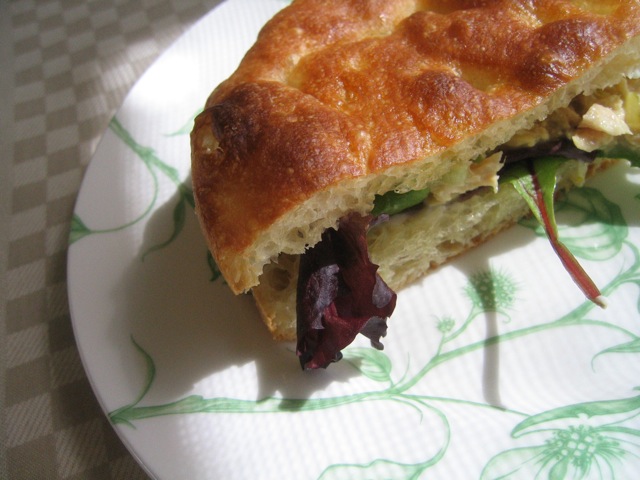
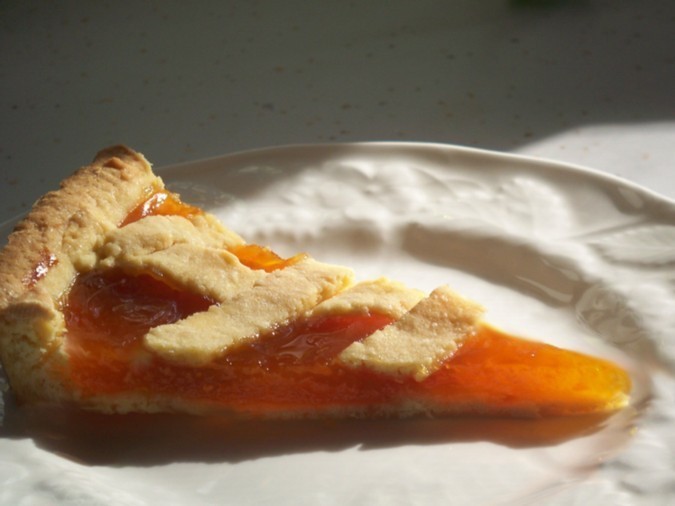
All of the images above are good examples of natural off camera lighting. Thanks to Mark, Susan, and Pamela and also Stephmo for the Pretzels shot.
This will be a work in progress and added to as I get time. If you have questions, fire away and I'll do the best I can. This is a big subject that could get very specialized.
Eric


Comments
For taking the time to write on this subject. I think a lot of people are interested in documenting and/or showcasing their baked goods. I know I am. Photos are powerful. -Debbie
That's a great introduction to lighting issues, especially. There are other issues like controlling depth of field, problems with digital zoom (as opposed to optical zoom), etc. which are also pertinent to this discussion.
You've prompted me to think more about my camera settings.
I think a chapter on photographing baked goods in the TFL Handbook would be appropriate. It should also include video techniques, about which I know zip. Mark Sinclair and SteveB have done such nice work on their videos, I'd love to hear what how they go about it.
Are you aware of any web sites focused on food photography? (I haven't looked yet, but will do so.)
David
I used to work for a well-known photographer. I learned a lot from him and bought an early Canon EOS. But then I diverted my attentions to other things. Now I have a digital point-and-shoot and am about to graduate to DSLR (Canon Rebel, to take advantage of my existing equipment), just as soon as I find an extra $800. I need a good review of what I learned, not to mention more time experimenting with the manual mode of my point-and-shoot.
Rosalie
I just wanted to point out that modern monitors are 96 dpi and as far as I know Nikon SLR's save files in 300 dpi.
Mike
Mike,
Actually, this is one of the least understood aspects of digital imaging. Cameras don't record at a specific dpi. All digital cameras record at the rate selected (good/fine) which then creates a file of a certain size. For example 3872x2592 is the size of the image in pixels of my largest file size. Multiply those numbers and you get a little over 10 Million bytes or pixels in every image. The dpi is not a measure of the quality of the image, the size is. The dpi is only important to the media you use to display or print on. In the case of computer monitor, Windows based monitors do display at 96 dpi as a rule and Apple based monitors at 72 dpi. That means that a 4x6 inch image on your screen need not be larger than (4X96=384 by 6x96=576) or 384x576 which will be a file size of roughly 221kb. These are the Windows version, mac would be smaller.
The confusion about resolution is made worse by Photoshop which shows the dpi tag of the image under Size. Keep in mind you need to know in advance what dpi level the intended output device will support (printer, monitor etc) BEFORE you re size an image. If you use a 600 dpi laser printer to print an image sized for a 72 dpi device, it will not be as clear and sharp as if you had unchecked "resample image" before the operation.
KEY POINT
For our purposes here, some people have trouble trying to upload images they have just taken with out re sizing them. The native files are to large for the forum server by many times, so they get an over size error. Users need to understand that files need to be either sized to 72 or 96 dpi or stored on a photo sharing repository like Photobucket. I'm not certain but I'm pretty sure Photobucket provides a monitor appropriate sized image at the URL of the photo. It still will store your full size image but the web available image is re sized.
Hope this helps.
Eric
I didn't even know the camera's flash could be adjusted till you said it. Thank you! Pamela emailed me a copy of the manual, which I could be more easily read since I could zoom it. And I did find out and CAN adjust my flash now. Also I worked with adjusting my color temp. As I told Pamela, I won't know all this by heart for a while, but I have something to work with. THANK YOU!!!! I notice the histogram on photo review. On there can I adjust the color temp if I'm not satisfied with it or just wait till I download them on the computer and go from there? I would think they put that on the camera for some reason. If it is beyond my beginner knowledge, just tell me. I have thick skin! You have been a big help Eric, thanks a million.
Audra
Audra,
On your camera the histogram in the view mode shows you the range of the exposure. Here is a link to an excellent discussion of how to read a Histogram. If you have a camera with this feature (you do) I would urge anyone to learn how to read the Histogram. It is a very helpful feature for understanding how to expose an image within the dynamic range capability of your camera.
Your best on camera tool for adjusting the color balance is the white balance setting. Look in the menu under the camera shooting options. To have access to the various presets you have to be in one of the Manual modes and not Auto or Macro. I use a custom white balance setting I created from using a gray card in our kitchen light. The Florescent is pretty close for most lights. You can also manually adjust the color temperature from that menu item. Hope this helps.
Eric
It took my 10 year old son to point out my best chance at a decent picture. I have been overexposing my food pictures all the time. One of our cameras- a Pentax Optio - just a little thing that can go underwater - has a setting for taking pictures of food. What a difference! There is much more that can make my pictures better, but this is an easy start. Other cameras might have it, I never knew it was there, it is one of the choices listed if you push the "mode" button.
Not professional photography, but a useful little thing.
Marni
since I now know that I can adjust the amount of flash coming from the camera, can I set the camera flash low and use the slave flash set somewhere from a distance and at a different angle for better results? Or does the amount of slave flash adjust right along with the camera? Boy that got long. Sorry.
It is starting to come together in my mind finally. I have had this camera 4 months, and you have taught me more in what 2 days than I had learned all together. That and Pamela emailing me the manual so that I can see it in zoomed print now! I played around with it a long time last night. Went outside and had it set for indoors/ low light. I had forgotten about slowing down the shutter speed. Everything came out bleaches and I was very frustrated. But I didn't give up and finally remembered what I had done and sped up the shutter until I was satisfied. Thanks to you Eric, I think I will start to finally enjoy my camera like I thought I would when I got it.
I know you did this as a job. Please send me a bill for your services. I am so grateful for your help.
I have started reading the histogram Linc you posted. I will continue when the children are asleep. Wow! The shots on there really are dramatically different just from making adjustments. I never knew. I have a LOT to learn. You are an inspiration. I will never come close to your skill either with baking or with photography, but thank you for bringing the fun and curiosity back. It is all now new again, as I see it all through new eyes. the lens of a camera.
Audra
Audra,
You haven't said directly but I suspect you have the Nikon master flash unit. If this is true, you can set both the on camera flash intensity and the remote flash. The computer in both units will decide how bright to make the flash depending on the camera settings and what you have set the remote unit to behave like. This is a little like shooting a portrait of a person only it's bread. The primary or Key light should not be the frontal flash. Think about your loaf in the dark in front of a black background. Now set the side light to provide enough light to illuminate that side of the loaf at about a 45 degree angle to the camera. If you take that picture and there isn't any other light in the room and the walls are dark so they don't bounce light back, you have very dark shadows on the unlit side. Like the moon in crescent. Now, assuming the same distance between the subject and camera as subject and remote flash, set the camera flash at 1/4 of the power or a 2 F stop lower setting. Now the shadow is lit but only with 1/4 of the light as the side. That will be enough to see details like the open structure in the crumb shot. Now if you want to make it just a little more studio like, place a white cardboard just out of camera view opposite the side flash. This arrangement will give you good exposure on one side, fill flash from the camera angle and bounced soft fill from the dark side. If you don't have the Nikon flash, let me know and I'll redo my response to fit your situation.This is all overkill for snap shots but a small effort will reap large rewards.
I'm not suggesting that you actually do this with every picture but learning the concept can be a big help in all kinds of situations. With your remote adjustable flash you can do some very creative things. Another thing to keep in mind is that you can use both of these strobe units as fill flash in addition to the sun. Just a little wink to take some of the contrast off the harsh sun.
I'm not doing this for billing. I want to help people understand their equipment and learn enough to not be frustrated with basic tasks. With a little knowledge you can do quite a lot and all your photos will improve. That said, if you feel compelled, please make a contribution to Mercy Corp which will in some way help our gracious host.
Eric
Found myself understanding what you are talking about on the flash issues. I had noticed from taking Halloween pic's in the dark, and a few camp out pictures of the kids, what cool results you can get in the dark. I had no idea what I was doing with the Halloween shots, since the camera came out of the box that very evening, but they turned out very cool. My old camera had a much slower shutter speed on night shots (aim and shoot) and we took some neat shots of the fire. They were all swirly and red, orange, and yellow everywhere, but I haven't been able to duplicate them with my Nikon. After reading your instructions, I hope I can broaden those horizons.
I tried some practice shots like you recommended on the bread last night. Set it up, turn out the light... My husband came in and burst out laughing! He said "what are you doing? They wouldn't come outlike you wanted in the window awhile ago and so you thought you'd sneak up on them !" We laughed and laughed! I haven't got the whole process down yet, but progress has been made. Right now I keep changing things to get a shot and I keep forgetting what I changed. It is a lot to keep up with to start with. I'm sure practice will help. I have started making notes on settings and keeping them on a card in my camera bag. A cheat sheet if you will. I hope to not need it before long.
And I would be happy to contribute to the Mercy Corp fund. It is a shame to think of all the bread we eat, make and share and there are children hungry all over the world. What I great idea. Thank you again Eric.
Audra
Audra,
The thing with shooting at night was to get you thinking of how the light can be predictable. Studio lights can be set at various power levels so as to create the desired contrast from shadows cast by the strobe lights. Keep it simple at first but experiment with changing the things that affect shadows. That would be, flash power, distance between flash and object, diffusion filters like cheese cloth, bounced or natural light and of course angle of lighting.
The really great thing about shooting digital is that you can see your results immediately and it's free. You can play all afternoon and really learn how the changes you make will predictably change the shot.
Why don't you send me some examples of what you are experimenting with so we can talk about them?
Eric
It will be weekend, before I will be free to get it done. I won't overwhelm you, I promise.
Audra
from breakfast. The first one was taken indoors and I think is too bright. The detail is lost to me. The second, better detail but still a little bright. The third and forth were taken outside, conditions cloudy. I took about 30 and narrowed it down. So far I think the only thing improved is the color balance somewhat. There are not quite as yellow. Go ahead Eric, hit me hard. I know I am way off from what they can be. The camera has the capability of great shots, if I can do my part. Pamela has uploaded some very nice shots this week. VERY clear. I can't ever seem to get the focus that clear on close up shots. If I move the camera that close the focus won't lock on, and if I back up and zoom, they are not as sharp. Is this a job left top the zoom/crop, and sharpen on my photo editing software? I hope I am not a pest about all this. Like I said, I would have loved to have taken a class. I understand you cannot pack months of learning into a few paragraphs on the computer. I have read and re-read the histogram article. Any other suggested reading would be appreciated. Anything to help you help me with out having to type yourself to death! Thank you again.
Audra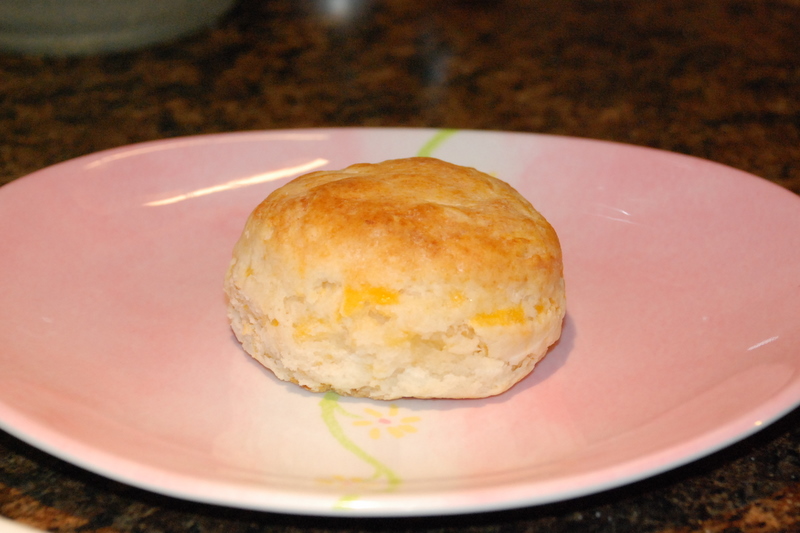
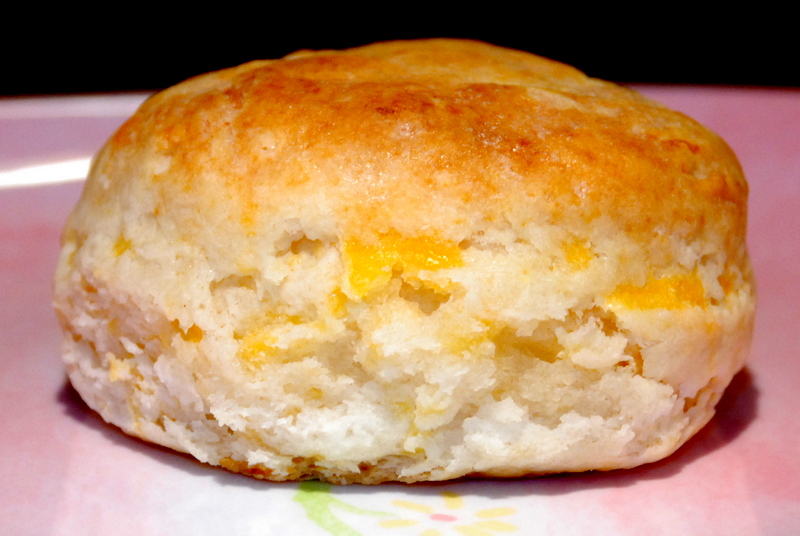

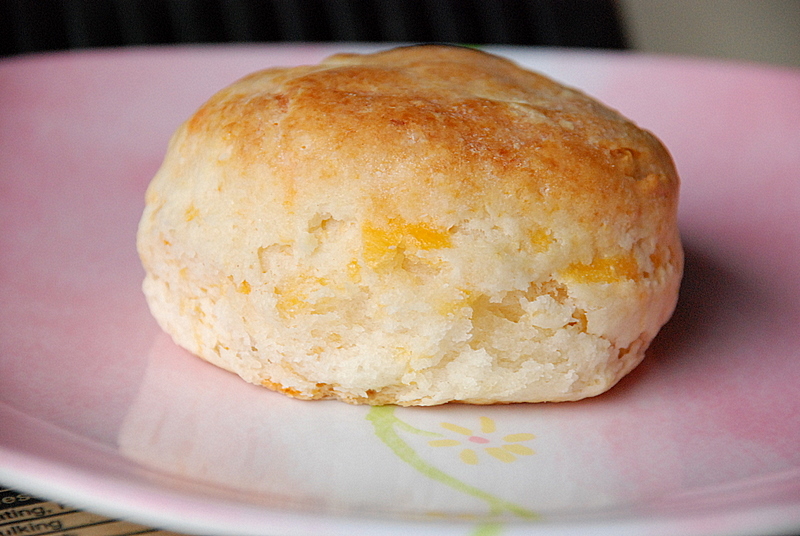
Audra, did you take these using natural or artificial light? It looks like artificial to me because of the purplish cast. In any event, I think you are definitely improving (said by one novice to another!). Try getting more on top of the biscuit and perhaps making an arrangement of several of them together. Also, I think you might be shooting with too many pixels (don't know how to say this correctly)--what I mean is look at the size of the picture. Are you shooting a 4 x 6 inch picture? It looks larger to me (again I know almost nothing so feel free to disregard my comments!).
--Pamela
I have the size set as large, since I thought that set on large, it would be clearer in a larger picture. No? Such as, when I photograph something that I might want to make a large print of, the smaller version would be even clearer. (duh, I know, I don't want an 11x14 of my cheese biscuit) This is not correct, is it?
And yes, 2 of them were artificial light. The other was on the back porch, with a little flash, as it was raining, but I had the flash cut way down. Still way too harsh huh? I thought so too. Your buns above look so soft, and the photo is pleasing to the eye. Since we eat first with our eyes, yours should be on a menu! They would sell out immediately! Whether your are warm and soft like this one, or clean and crisp like the loaf and the cactus, they are excellent. You have worked hard and have a great understanding of your camera. When you get ready to print your own cookbook of your breads you will have some great shots to go in there.
The pixel thing still intrigues me. I thought I bought a camera with more pixels to take clearer pictures. Hmmmm....
Right, you don't want an 11 x 14 inch cheese biscuit because among other things it would be too fattening! Have you ever noticed that the picture on a small flat screen TV or computer is sharper than on a larger one? I think something like that is going on with the size of the picture on the camera. Even if it is raining, as long as there is some natural light, you ought to be able to take the picture with out flash--if there isn't much light I set my exposure level to +2. Keep working at it; you're getting there.
--Pamela
I did try to ( indoor) cut the frontal flash way down and sit my slave flash over to the side , but never got exactly what I wanted. Is that do-able when it is night or you just don't have natural light? Maybe rigged up as a diffuser like in the portrait studio behind a sheer curtain. I may be over thinking all this. I don't want the emphasis to be the photo not the bread but, I realize how much difference the picture makes. A friend took a photo of my daughter at school, and sent me a copy. The light was great , her smile was perfect, and my friend didn't take the red eye out of the photo. `: ( . A great shot gets my attention, of bread I might have just passed by, then I take my time and read on. Etc. Thanks for all your help. I don't know about getting better yet, but I can correct my mistakes faster now! One day!
Are you able to adjust your exposure level? Look in the manual for how to adjust it. It goes from -1 to +2. -2 is what you use when there is a ton of sun; +2 is when there isn't much light.
--Pamela
I took this mid-day in my kitchen. There was some natural light but not enough so I turned on the overhead light (*not* fluorescent though). My exposure was set to +2.
your crumb shot is well focused, and the light is not overly harsh like mine. You mentioned my last shots being too purple I think, I had thought the old ones were too yellow or warm . Did I over compensate when I tried to adjust that out?
I am really having a difficult time getting the light to suit. It will be too dark and I adjust a tenth at the time and then it is too light. It goes dark, dark, dark too bright. If my home lighting was better, I probably would not have so much trouble because I wouldn't have to rely on the flash so much. The ceilings are about 14 feet and stained wood that really does not reflect at all. No ones house is perfect for everything. I may just have to come up with a small staged place with adequate light for this purpose. My overheads are can light fluorescent, with added chandeliers that also contain fluorescent bulbs. But with the stained wood ceiling, they put off a yellow light.
I put the bread on my peel, set it on a small trash can, and moved it next to a plant by a sunny window and two semi-sleeping dogs. Working quickly and having to keep an eye on both bread and dogs, I managed to get a pretty decent shot.
--Pamela
Yes I think you've got it! Nice looking bread, beautifully presented and photographed.
David
The shadows make it look very cool. And the crumb is very focused. The cactus ain't bad either! You take such clear shots. I am envious!!
This is a very valuable post for those of us who fumble around with our cameras. (And someday I will graduate up to an SLR.)
Like you, I'm always taking my crumb shots at night, and figuring out how to balance the interior light and the flash has been tricky. You've given us food for thought.
Thanks, Eric!
David
Same here, usually having to ask my breads to model for me at night time :)... I will try natural lighting sometime soon. See how that works. Thanks for all the great info here!
Hazim
It's pretty overcast here today, so I took my cracker to the front window sill and shot it without flash (macro) close up using ISO 400 & +2 exposure. It came out pretty good. (No light box, just a white window sill.)
--Pamela